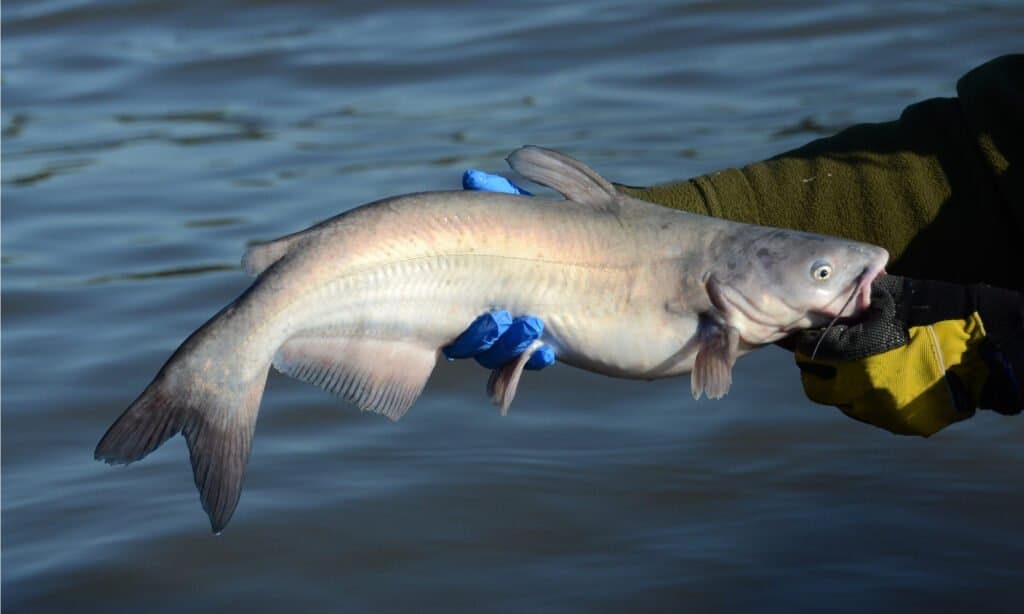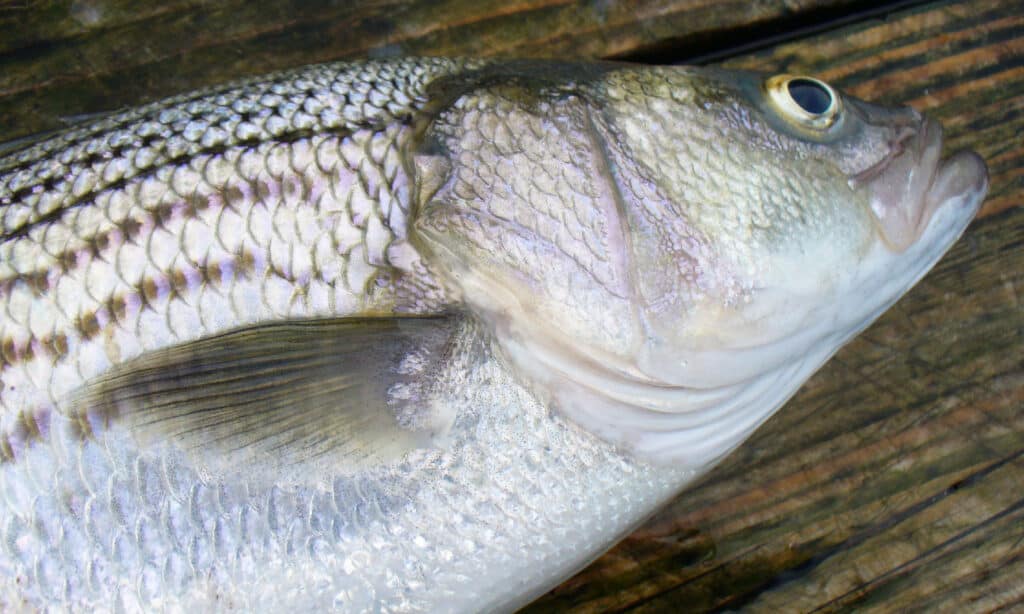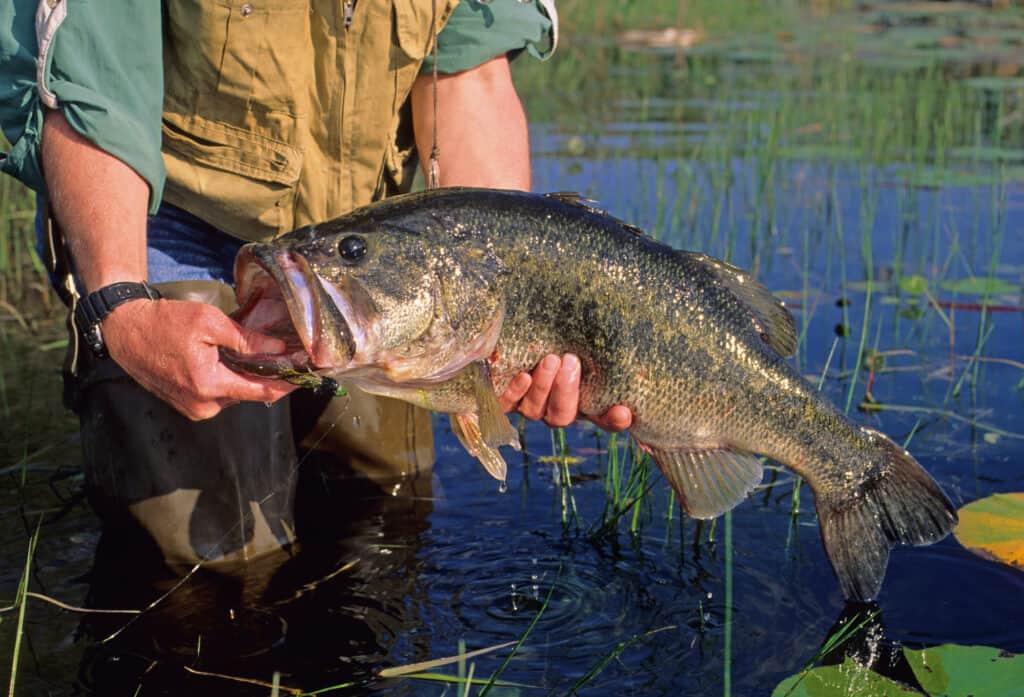The Tennessee River is known as one of the most diverse rivers in North America. It is the largest tributary of the Ohio River and is 652 miles (1,049 km) long. It was once known as the Cherokee River since the Cherokee people lived along the river’s banks. This river flows southwest into Chattanooga, Tennessee, and then crosses into Alabama.

The Tennessee River is home to roughly 230 different species of fish, some of which are known to get quite big. Let’s take a look at some of the largest fish in the Tennessee River.
Blue Catfish

Blue catfish can grow up to 5 feet long and weigh as much as 100 pounds
©M Huston/Shutterstock.com
Catfish are one of the most common types of fish in the United States and the Tennessee River is no exception. Catfish can be commonly found in most lakes, rivers, and reservoirs in many states, whether they are coastal or inland. Blue catfish are native to Missouri, Mississippi, the Rio Grande River, and Ohio. In all other places that you can find this fish, they have been introduced.
Blue catfish are only one of the types of catfish that can be found in the Tennessee River and they can grow to be rather large. The normal size for an adult blue catfish is less than two feet but they can get as big as 5 feet long and can weigh over 100 pounds!
They were mainly introduced to serve primarily as a recreational fishing target. These fish are strong and they present a good challenge for fishermen. However, when these fish were introduced to the areas they were it was expected that they would stay in the general area, as it was thought that they only lived in freshwater. It was found out later that blue catfish can actually tolerate water that isn’t completely fresh.
This presented a big problem because now because the blue catfish were able to swim out of the rivers they were initially introduced in and enter bays and then swim out into other rivers that were fairly fresh. This allowed the blue catfish to expand into other areas and wreak havoc on the ecosystem. They got bigger as they fed on other native species and entered new areas. This is why recreational fishing of the blue catfish is encouraged—it helps keep the population under control. Luckily, blue catfish offer a fun fishing challenge for anglers and can make a tasty meal.
You can tell a blue catfish by its flat dorsal fin and its tail that is deeply forked. The more obvious trait is their silvery-blue color. The underside of the fish is white and they lack scales, so their skin is smooth. You can also tell if it’s a catfish by the four barbels around their mouth area that resemble whiskers.
Striped Bass

The striped bass have 7 or 8 horizontal stripes running down their bodies.
©iStock.com/Coast-to-Coast
Striped bass is another popular catch you can find in the Tennessee River. It is not uncommon for striped bass to reach lengths of 5 feet and weights of 75 pounds or more. They are sought after by anglers of many skill levels. You can tell a striped bass by their stout bodies and the seven or eight horizontal stripes running along each side. The horizontal lines run all the way from their gills to the tail. Aside from the stripes being a defining feature, striped bass can range in color from olive, green, black, steel blue, or brown on the top and will have a white or silvery underside.
The females in this species are able to reproduce when they are between 4 and 8 years old, while the males are ready between the ages of 2 and 4 years old. The female striped bass produces a large number of eggs which are then fertilized by the male. The larval striped basses that are born will consume microscopic animals like zooplankton. As they grow, the juveniles will begin eating new creatures like insect larvae, mayflies, small crustaceans, and other types of larval fish.
Once they are adults, they will become piscivorous, meaning that they will eat other fish. Striped bass will eat nearly any type of small fish that it can. They will also consume invertebrates like squid and crabs. Young and small striped bass have to be on the lookout for predators like silver hake, cod, weakfish, and bluefish, while the adult striped bass has fewer predators. The main predators the adults have to worry about are sharks and seals. However, striped bass can live for quite a long time for a fish. They can live up to 30 years, but their growth depends on where they live.
Largemouth Bass

You can identify a largemouth bass by its large, slender mouth and its plain underside.
©iStock.com/stammphoto
The largemouth bass is another popular fish in the Tennessee River and they can grow to giant sizes too. Most largemouth bass will reach about 16 inches in length. The longest recorded largemouth bass was 38.2 inches in length, and the heaviest was 22 pounds. The maximum reported age for a largemouth bass is 23 years old.
You can identify a largemouth bass by its large, slender mouth. The upper portion of the jaw will extend beyond the rear margin of its eye in an adult largemouth bass. It has a broad black stripe down its side, similar to the spotted bass, that is usually blotchy or broken. You can tell the difference between a largemouth bass and a spotted bass because the largemouth bass will have a plain underside, while the spotted bass will have rows of black spots.
These fish can inhabit a variety of habitats including ponds, clear, vegetated lakes, swamps, rivers, and creeks. The adults utilize the vegetation, logs, tree limbs, or stumps as a form of cover to hide from predators, or as a way to ambush their prey. They prefer to spawn in areas that have mud, gravel, or a firm bottom of sand. Spawning happens during the spring when the water temperature rises between 59 and 75 degrees Fahrenheit. The males will build a safe nesting area for the females by hollowing out a circular-shaped area in the bottom substrate for the female to lay the eggs in (which helps protect the eggs after they’ve been fertilized by the male).
Up Next
- How Deep is the Tennessee River?
- How Long is the Tennessee River?
- Meet 10 Snakes of the Tennessee River
- Spotted Bass vs Largemouth: 9 Key Differences Explained
The photo featured at the top of this post is © Billy Ogle/Flickr – License / Original
Sources
- Wikipedia, Available here: https://en.wikipedia.org/wiki/Tennessee_River
- Tennessee Riverkeeper, Available here: https://www.tennesseeriver.org/species.html
- NOAA Fisheries, Available here: https://www.fisheries.noaa.gov/species/blue-catfish
- NOAA Fisheries, Available here: https://www.fisheries.noaa.gov/species/atlantic-striped-bass
- Kentucky Department of Fish & Wildlife Resources, Available here: https://fw.ky.gov/Fish/Pages/Largemouth-Bass.aspx
FAQs (Frequently Asked Questions)
How many fish species are in the Tennessee River?
The Tennessee River is home to 230 different fish species.
How long is the Tennessee River?
The Tennessee River is 652 miles (1,049 km) long.
Can you boat on the Tennessee River?
Yes, boating is allowed on the Tennessee River and is a popular recreational activity.
Thank you for reading! Have some feedback for us? Contact the AZ Animals editorial team.






